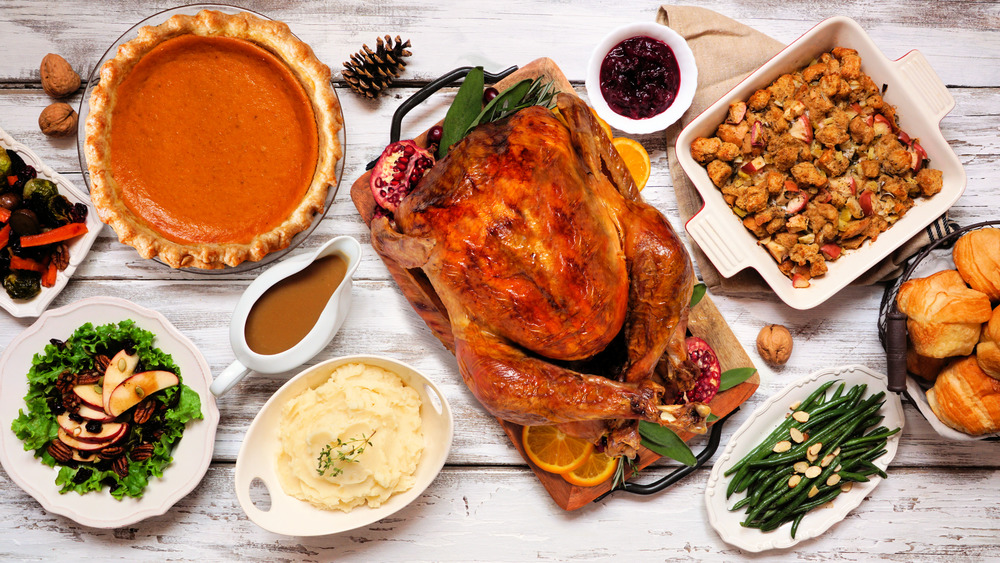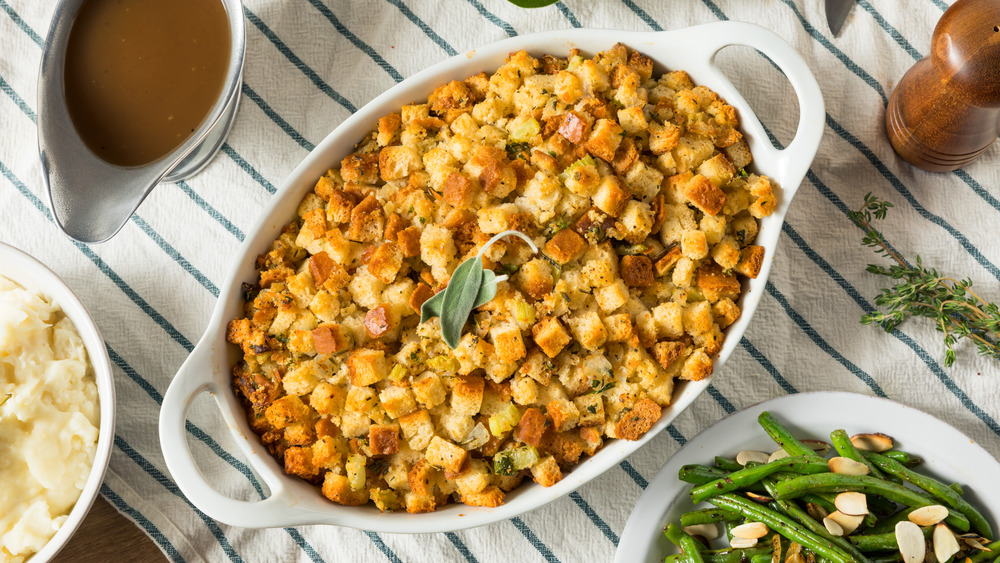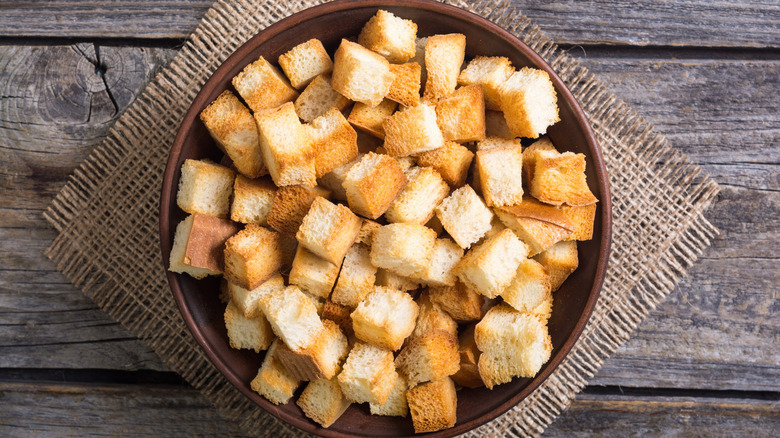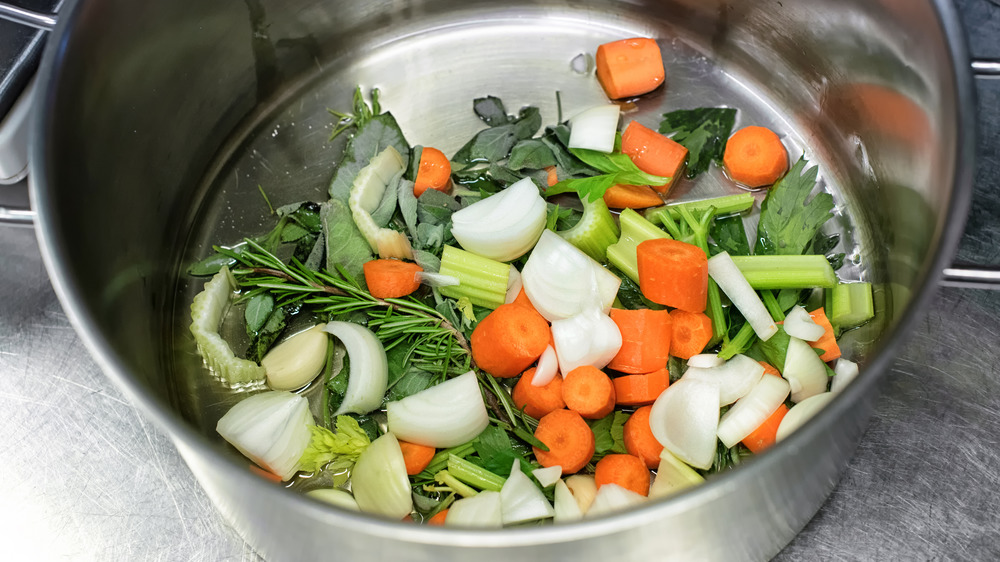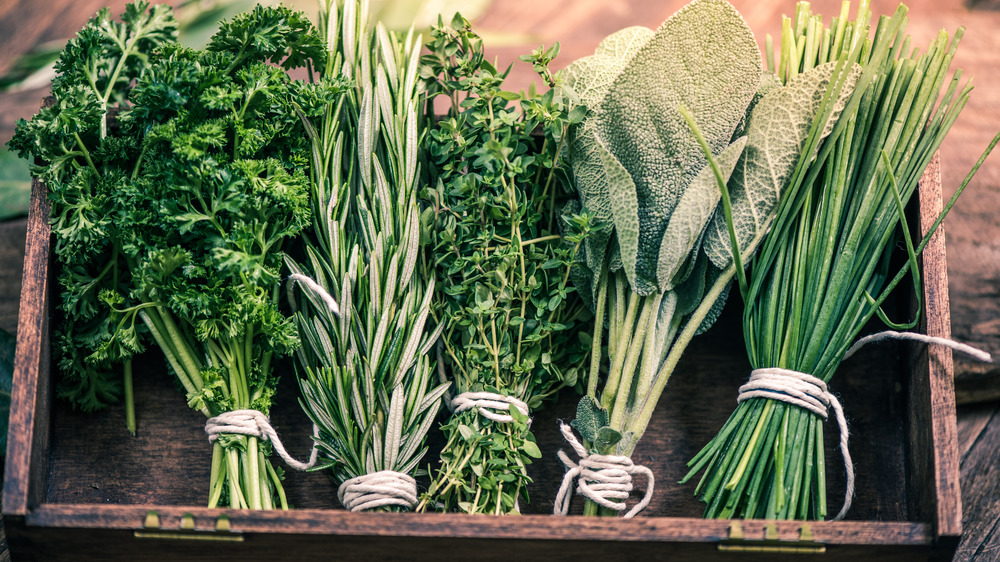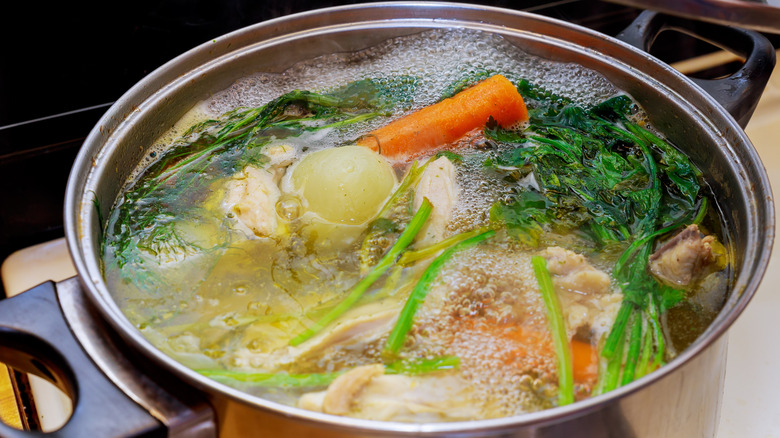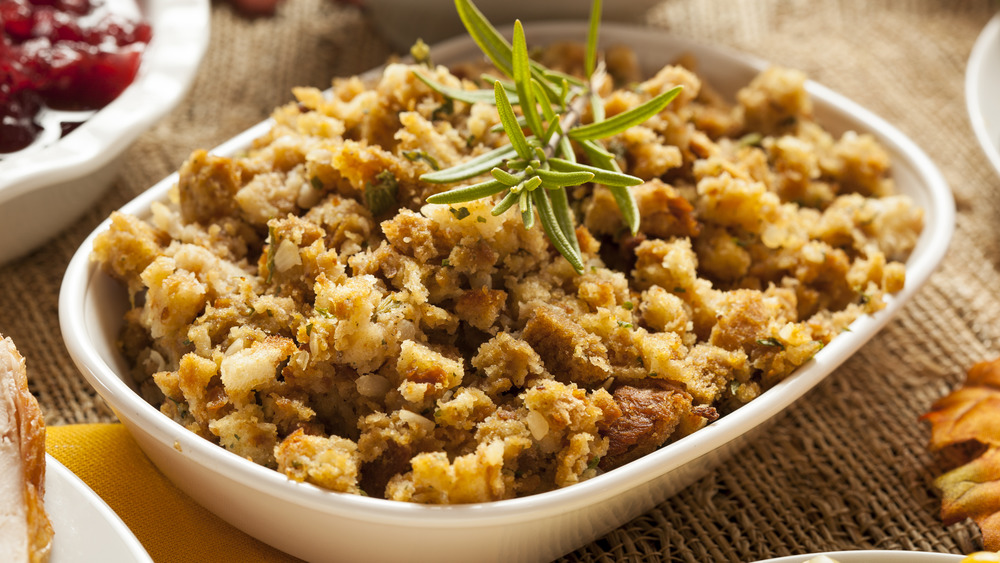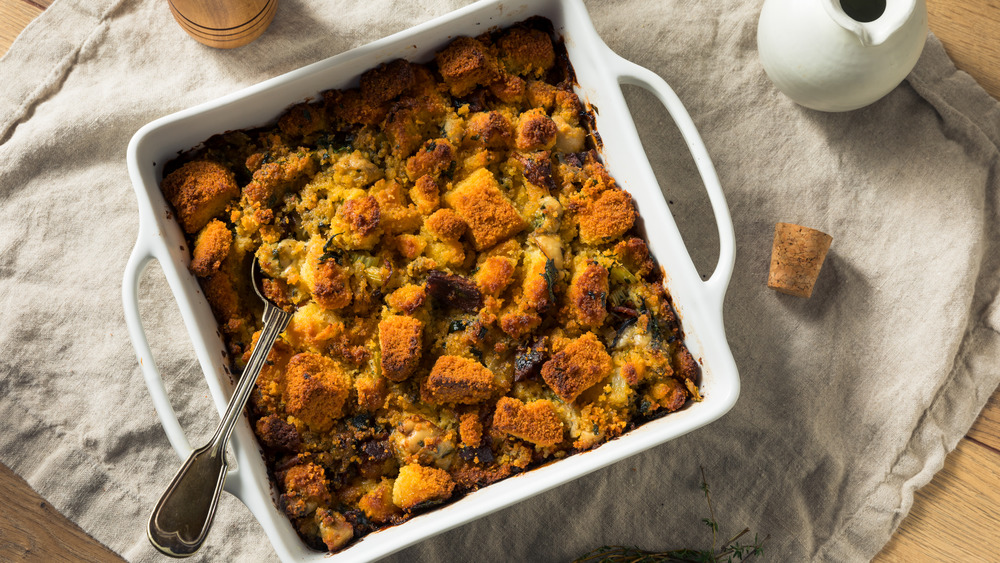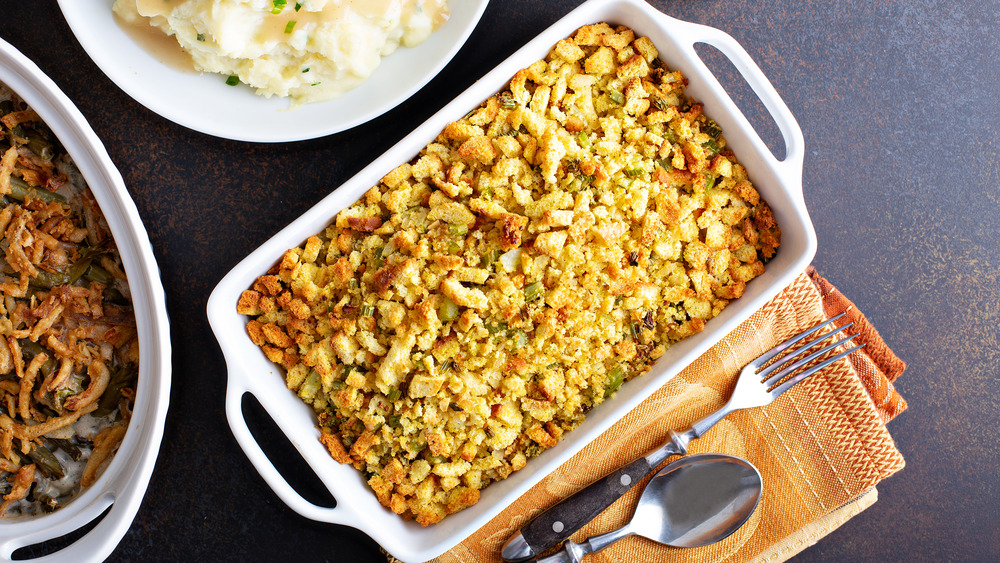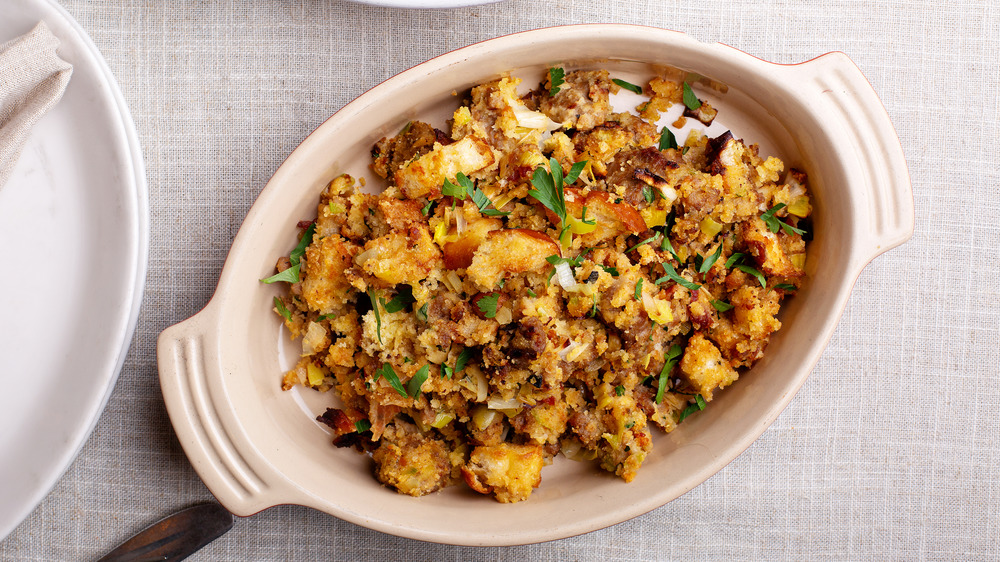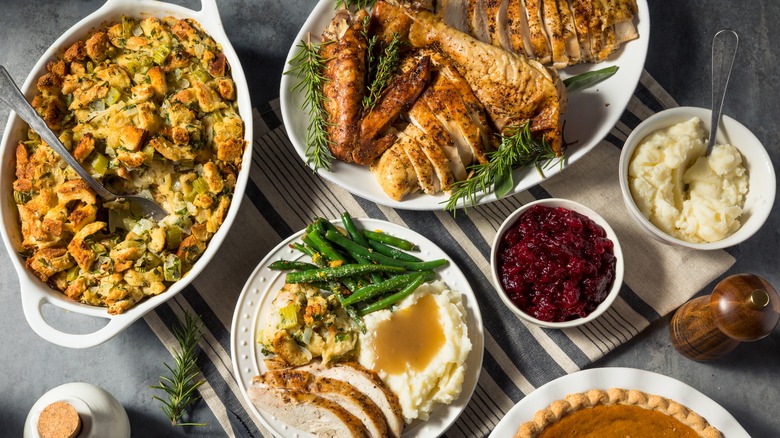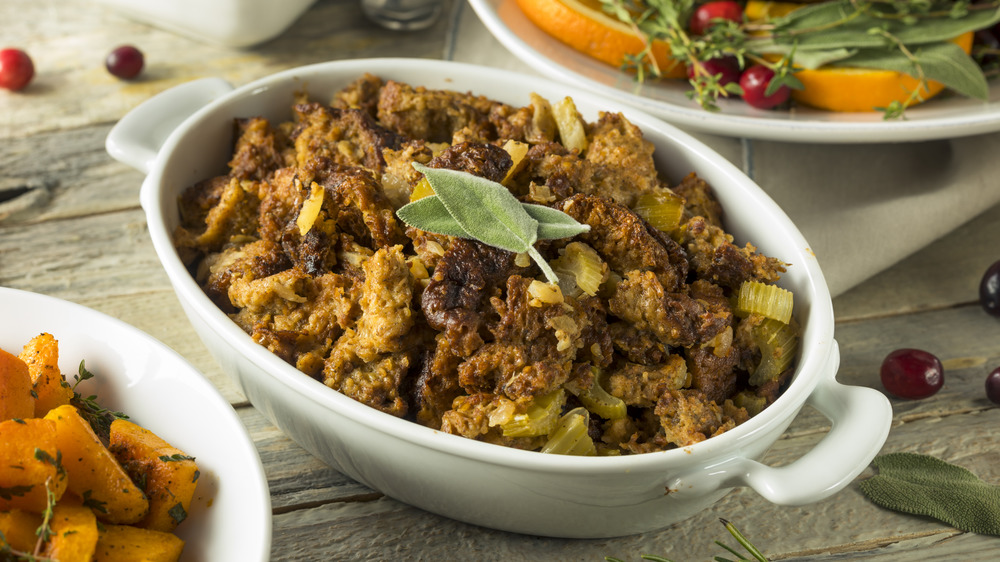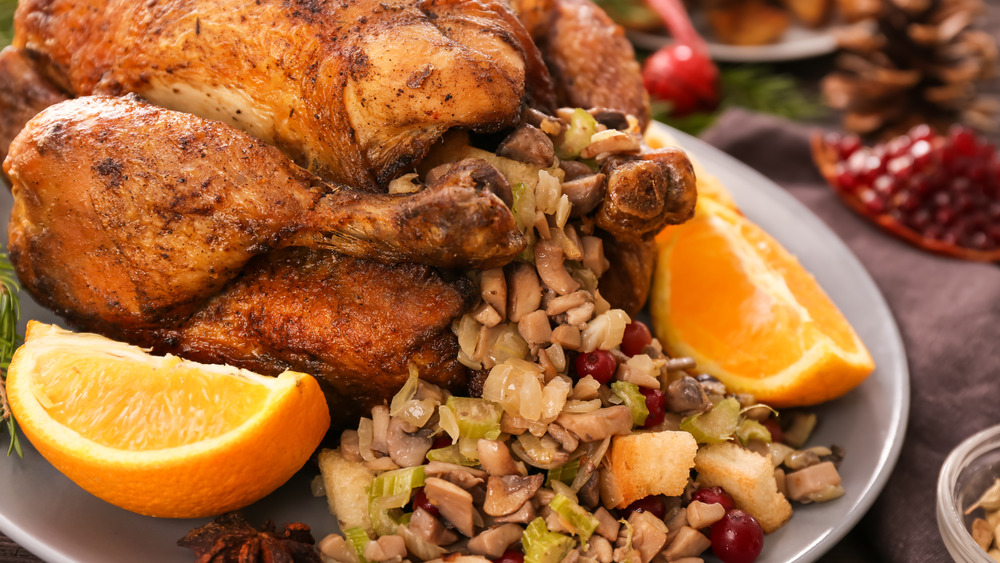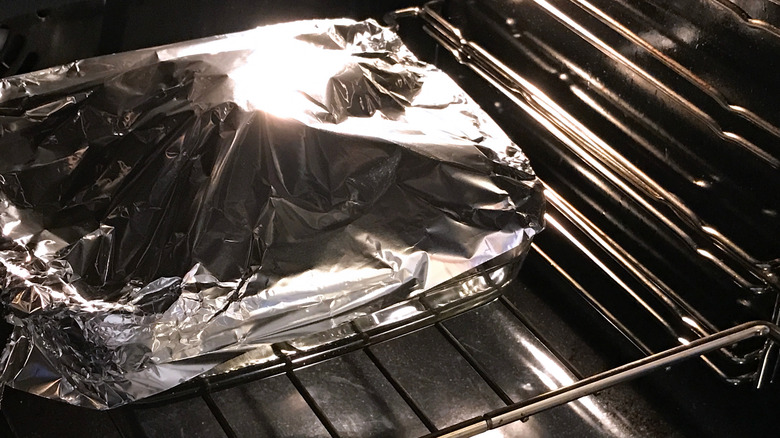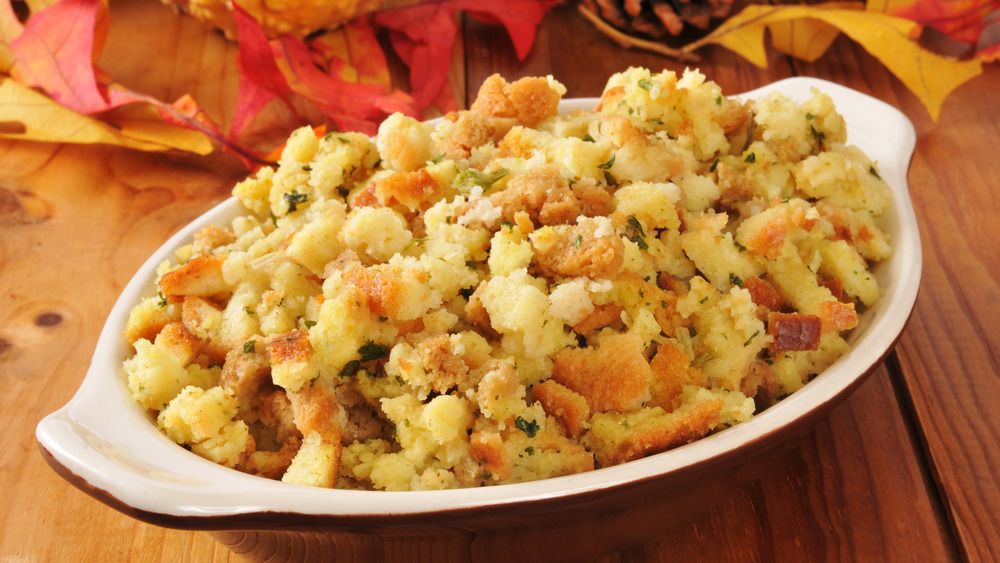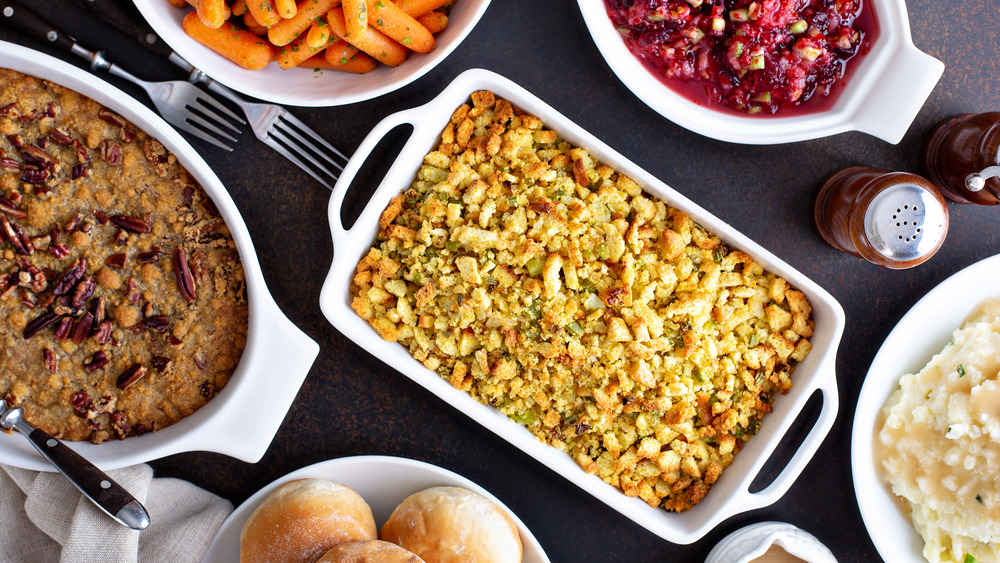Mistakes Everyone Makes When Making Stuffing
When it comes to Thanksgiving, stuffing is a staple side dish. Whether you actually call it by that name, swear by the term dressing instead, or don't understand the difference, chances are there is still some version of the dish on your table on turkey day. In fact, The Washington Post argues that "no other Thanksgiving staple better reflects the nation's diversity than the side dish known as stuffing."
At its basic core, stuffing is a combination of starch and other ingredients (usually vegetables and herbs) that soak up liquid while baking in the oven, either inside a piece of meat or in a casserole dish. There are endless variations on how you can make stuffing and what you can put it in. But there are right and wrong ways to do it, and certain rules must be followed. Keep reading for the mistakes everyone makes when making stuffing — and how to avoid them.
Using fresh bread for your stuffing
While it may be a natural tendency to assume fresher is always better, that's not the case when it comes to stuffing. One of the worst things you can do when making this dish is use fresh bread. The soft, airy texture will quickly become soggy the moment you add the wet ingredients. Make this mistake, and what you'll end with is nothing short of a mushy, unappetizing side dish that no one will be reaching across the table for.
No matter which variety you decide to use, the key to a great stuffing is to use stale or thoroughly dried-out bread. It will soak up all the delicious flavors you are adding to your stuffing, while maintaining some hearty texture. Food Network chef Sandra Lee advises cutting your bread into cubes and then letting it sit out on the counter for a day or two to get stale. But if you're crunched for time, Serious Eats also recommends toasting your bread cubes in the oven at 275°F for about 45 minutes, tossing it a few times to dry out all the pieces evenly.
Chopping your bread into perfect cubes
Once your bread is perfectly stale and ready to soak up all the glorious flavors of your stuffing, it has to be cut up into bite-sized pieces to make up the backbone of this traditional Thanksgiving dish. Most stuffing recipes call for chopping up the bread into evenly sized cubes before tossing them into the mix, but there's actually a better method.
Tearing your bread into pieces with your hands rather than cutting it up with a knife, as Martha Stewart's website calls for in its simple stuffing recipe, will actually yield much tastier results. Tearing the bread will ensure that each piece is rugged and slightly differently shaped, creating more surface area to soak up all the warm, earthy, comforting flavors inside your stuffing. And as an added bonus, having jagged, hand-torn pieces of bead will also assist in achieving the ideal, crispy, browned crust on the top.
Not cooking the veggies for your stuffing first
Vegetables and aromatics are important texture and flavor components for any stuffing recipe. Many classic versions, like this recipe from Martha Stewart, call for onions, celery, and garlic at the very least. But there are truly endless possibilities as to what you can add to a stuffing recipe, from shallots, carrots, and leeks to ginger, mushrooms, cranberries, and more.
No matter what you're including, it is a cardinal sin to add these ingredients to your stuffing uncooked. Food blogger Cafe Mom says this mistake "will leave your stuffing devoid of important texture and flavor." Not only are you denying these aromatics the chance to moisten and release their fragrances before baking, but you're also running the risk that all the ingredients in your stuffing will not be cooked evenly. For the best results, the food experts at All Recipes recommend sautéing your veggies (and any other ingredients you plan to add to your stuffing) in a little bit of butter for a few minutes until they are tender.
Using dried herbs instead of fresh for your stuffing
While fresh bread is a definite no-go when it comes to stuffing, when it comes to your herbs, fresh is always best. Whether you're throwing in the classics, like sage, thyme, rosemary, and parsley, or spicing things up with the likes of basil, dill, oregano, or maybe even tarragon, this rule still applies. Fresh herbs have a brighter and more vibrant flavor than dried herbs, which have more concentrated, earthy notes.
While there are certainly times when one is better to use than the other, for a celebratory dish like stuffing, you want to stick with fresh herbs, which "will give you maximal flavor and fragrance," according to Eat This, Not That!. If you're putting hours if not days of work into your Thanksgiving feast, you want it to be the best dish it can possibly be, and fresh herbs can make that happen.
Not using broth or stock
No one wants to be hungrily waiting for Thanksgiving dinner to begin, only to soon take a huge bite into dry, flavorless stuffing. The liquid that you use in your stuffing recipe is a key component to the dish. And while a lot of different liquids will do, including water, you'd be making a huge mistake not opting for broth or stock for your dish.
Broth and stock impart so many savory flavors that get absorbed by all the bread in stuffing. And while seasonings and spices themselves do go a long way, they won't be enough to overcome a stuffing made with water. It's just not the same as the infusion you get from a stock. Plus, there are vegetarian, low-sodium, and fat-free versions that can fit into any diet.
Bonus points if you go for the ultimate flavor hack and make your own homemade stock or broth.
Adding in all the stuffing stock at once
Achieving the perfect stuffing texture comes down to your ratio of wet and dry ingredients. The balance has to be just right to make sure the components actually come together without leaving your bread totally soaked and soggy. The easiest way to make this mistake and throw off your ratio is to add your chicken stock to the recipe all at once. If you do that and there turns out to be too much liquid in your mix, the stuffing is pretty much ruined before you've even baked it.
To avoid this pitfall, Bon Appétit advises adding stock to your recipe slowly, about a half a cup at a time. You can always add more until you reach the right ratio. And what exactly does that look like? The Kitchn says the "bread should absorb the liquid without leaving a puddle at the bottom of the dish."
Oversalting or overseasoning your stuffing
There are a lot of flavor components that go into a stuffing, from the veggies and aromatics to the fresh, savory herbs. There's also the butter, broth, and bread, which can be packed with sodium. And that's before you include the customizable add-ins like sausage, bacon, nuts, spices, and more. What can result is a stuffing that has way too much salt or is over-seasoned.
There are a few ways to avoid this mistake. First and foremost, Eating Well says that making stuffing from scratch, rather than using a box mix, is the best way to go because you have better control over the amount of salt and seasoning that will be added. When it comes to adding extra ingredients, be "judicious" with how much you use. Things like sausage and bacon inherently contain a lot of salt, and a little goes a long way in your recipe. Other tips include using low-sodium chicken broth and tasting your stuffing to see if it actually needs any extra salt added to the recipe.
Overpowering the binder in your stuffing
When you add extra ingredients to your stuffing, over-salting isn't the only risk that you take. Using too many mix-ins could also make it harder for your stuffing to come together in the oven. The most prominent dry ingredient in your stuffing must be the bread, which soaks up almost all of the liquid and acts as the binder for the dish. If you overpower your binder, then your stuffing will not hold together, but rather, start falling apart the moment you try to serve it up. Keep that in mind when choosing what kind and how many ingredients to add to your recipe.
Epicurious' guide to making stuffing suggests using about twice as much bread as you do other ingredients. For example, a stuffing that serves eight to ten people should have a ratio of ten cups of bread to 3 cups of chopped vegetables and up to a pound of meat (which is roughly two cups).
Not keeping your stuffing ingredients separate
Another way to end up with soiled stuffing is to combine your ingredients too soon before baking. If you try and assemble your recipe ahead of time but wait to bake later, your bread will sit there in all that liquid and get really soggy, really fast. To prevent your dish from getting too mushy, Food Network advises waiting to combine your dry and wet ingredients until right before you are ready to dump the stuffing into a bird or casserole dish and bake it.
This is also a food safety issue. The USDA Food Safety and Inspection Service (FSIS) says stuffing, especially before it's cooked, is "an excellent medium for bacterial growth." So it's extremely important to handle and prepare the ingredients properly to reduce the risk of foodborne illness. For this reason, the FSIS also encourages cooks to cook their turkey and their stuffing separately.
Waiting until Thanksgiving Day to make it
No matter what dishes are gracing your holiday table, preparing Thanksgiving dinner is a lot of work. There are a lot of moving parts, and more often than not, it involves putting together a meal that can feed a crowd and then some. With that in mind, one of the easiest ways to set yourself up for stress is to try and make everything on Thanksgiving day. There are plenty elements of the meal that can be made ahead of time, and stuffing is one of those things that you absolutely should be preparing before Thanksgiving, especially if you want to make it of the highest, homemade quality.
You can easily start by drying out your bread a few days in advance so that it's nice and dry and ready to mix into your recipe. If you're feeling up to it, you can also simmer up your homemade stock a few days in advance. You can also cook down your veggies, herbs, and aromatics in advance and combine your dry ingredients as well. As long as you keep those ingredients separate for food safety reasons, you can have everything ready ahead of time. Then when the big day comes, it's simply a matter of mixing everything together and popping it in the oven.
Not getting the stuffing cook time right
In order to get the perfect stuffing texture, it's not just your wet-and-dry ratio that needs to be spot on. The baking time is also very important. If your stuffing is undercooked, it will mostly be a wet, soggy mess when you try and dish it out. On the other hand, overcooked stuffing can dry out quickly and become difficult to eat. Be sure to stick closely to the temperature and baking time instructions in your stuffing recipe.
And once again, this becomes a food safety issue as well, especially if you're using eggs in your recipe, which many call for. Food safety experts say anything with eggs in it needs to be cooked to an internal temperature of at least 160 degrees Fahrenheit to make sure any harmful germs that could cause food poisoning are killed. And for casseroles (which is technically what stuffing is), that temperature needs to be 165 degrees Fahrenheit.
If you need to make your stuffing ahead of time, another helpful tip from Cafe Mom is to undercook the dish just slightly, and then pop it in the oven right before dinner to reheat and finish cooking without drying out.
Cooking the stuffing inside the turkey
There is an ongoing debate about whether or not stuffing should actually be stuffed inside a turkey or simply made in a casserole dish. According to Food Network, the idea of not stuffing the bird was unheard of in the past, but these days, most chefs and food experts will tell you not to bother. Why you ask? Because the risks just aren't worth it.
Usually, one of two things will happen when you stuff your turkey. If you're focused on getting your bird cooked to juicy perfection, you risk undercooking your stuffing, which can create a serious risk of bacteria developing inside the bird and causing people to get sick. On the other hand, by the time you do get your stuffing cooked all the way through safely, there's a good chance you'll have overcooked and dried out your turkey. And let's be honest. All the gravy in the world can't mask that.
Leaving it covered in the oven the whole time
Stuffing takes some time and patience to get right. In order to cook it all the way through so that it's safe to eat and not soggy on the inside, it usually takes somewhere around an hour, if not longer, in the oven. In order to cook everything evenly and prevent the top of your stuffing from burning to a crisp, it's a commonly known trick to cover the top of the dish with foil while it bakes in the oven, trapping in moisture and lots of great flavors.
However, you'd be remiss to leave that foil covering on your stuffing the entire time that it's baking because you'll lose out on some wonderful textures. Instead, uncover your stuffing during the last 15 minutes or so of baking, once the center reaches 165 degrees Fahrenheit, so that the top of your casserole can crisp up and get a nice golden brown crust on top (via Recipe Tips).
Trying to be diet-friendly with your stuffing
Beyond giving thanks and watching football, Thanksgiving is about indulgence and comfort food. It's about eating all the turkey and sides we can contain, plus at least one kind of pie that we don't possibly have room for. It's about gravy and bread, and above all else, butter. It's not a low-fat holiday, nor should you try and make it one, if you ask us.
With that said, one of the biggest mistakes you can make when it comes to stuffing is to skimp on the butter. It's an essential part of the nostalgic, comforting taste we know and love in each bite of stuffing, which would simply not be the same without it. Bon Appétit says about half of the moisture in your stuffing should come from butter. This will help give the dish a richer flavor and texture, plus help achieve those crispy edges we all love.
Not having enough stuffing to go around
While the recipes vary from table to table, most people agree that stuffing is a Thanksgiving staple, if not a favorite part of the meal. So another fatal mistake that can be made when it comes to stuffing is simply not making enough of it. Typical Thanksgiving portion guides, including Food52's, recommend allotting three-quarters of a cup of cooked stuffing per person. However, that doesn't take into account how many people are inevitably going back for seconds on turkey day.
Not to mention, there are literally so many amazing things you can do with leftover stuffing for days after Thanksgiving is over (deep-fried stuffing mozzarella balls? Yes please!). It's important to keep all of these factors in mind when planning out how much stuffing to make for your Thanksgiving table so that everyone can have their fill and you've got some extras to get creative with later if you want.
